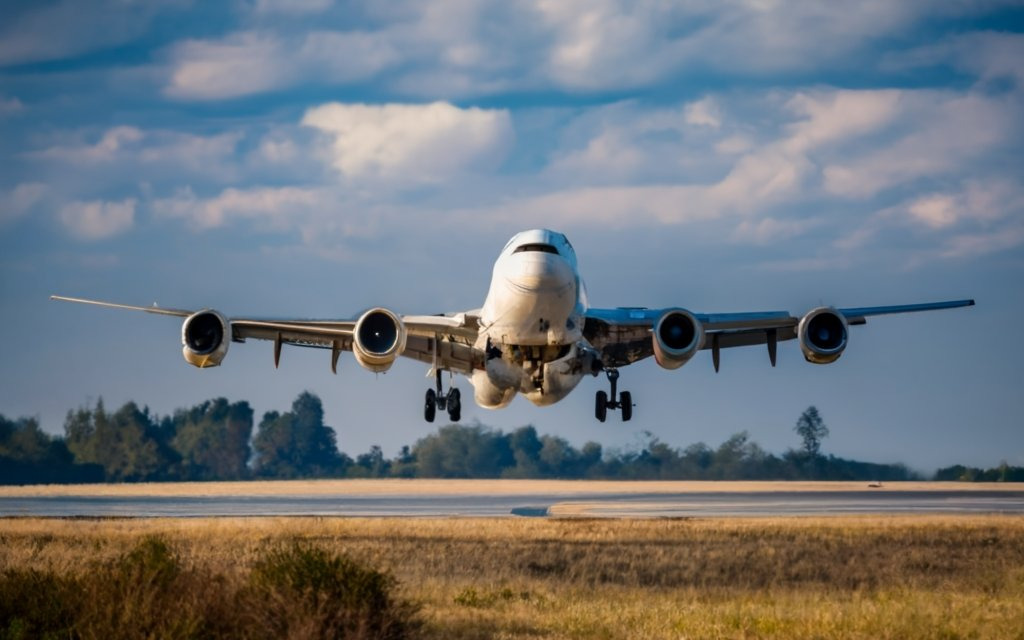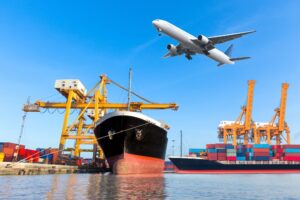If you are looking to ship goods from China to California, you might be wondering how long it will take for your cargo to arrive. The answer depends on several factors, such as the type of goods, the mode of transportation, the shipping route, and the customs clearance process. In this article, we will focus on one of the fastest and most reliable modes of transportation: air freight. We will explain the benefits of air freight over other modes of transportation, the logistics of air freight, the cargo packaging, the shipping documentation, the shipping rates and costs, the shipping timeframes, and the customs clearance and regulations involved in air freight shipping from China to California.
Benefits of Air Freight over other modes of transportation

Air freight is the transportation of goods by aircraft, either by commercial or charter flights. Air freight has several advantages over other modes of transportation, such as:
- Speed: Air freight is usually the fastest way to get goods to their destination, especially for long distances. Air freight can reduce the shipping time from China to California from 20-45 days by ocean to only 5-10 days by air.
- Reliability: Air freight has the lowest possibility of delays or disruptions, as flights are less affected by weather, traffic, or political issues. Flights also have fixed schedules and frequent departures, which means that you can plan your shipments more accurately and avoid missing deadlines.
- Security: Air freight has a high level of security, as airports have strict safety controls and cargo inspections. Air freight also reduces the risk of theft or damage, as cargo is handled less and stored in secure facilities.
- Flexibility: Air freight can reach almost any destination in the world, as long as there is an airport nearby. Air freight can also handle a wide range of goods, from perishable to hazardous, as long as they comply with the regulations and requirements of the origin and destination countries.
Understanding the logistics of Air Freight

Air freight involves a complex process of coordination and communication between various parties, such as shippers, freight forwarders, airlines, airports, customs brokers, and customs authorities. Here are the main steps involved in air freight shipping from China to California:
- Booking: The shipper contacts a freight forwarder, who is a licensed agent that arranges the transportation of goods by air. The freight forwarder books the cargo space with an airline, either directly or through a consolidator, who is a company that combines multiple shipments into one larger shipment to optimize the use of space and reduce costs. The freight forwarder also provides the shipper with a quotation, a contract, and an air waybill, which is a document that serves as a receipt, a contract of carriage, and a tracking number for the shipment.
- Preparation: The shipper prepares the goods for shipping, following the packaging, labeling, and documentation guidelines provided by the freight forwarder. The shipper also ensures that the goods comply with the regulations and restrictions of the origin and destination countries, such as the export and import licenses, the certificates of origin, the invoices, the packing lists, and the declarations. The shipper delivers the goods to the freight forwarder or the airline, depending on the agreed terms.
- Transportation: The airline transports the goods from the origin airport to the destination airport, either directly or with one or more stops or transfers. The airline also handles the loading and unloading of the cargo, the security checks, and the customs clearance at the origin and destination airports. The airline provides the freight forwarder and the shipper with updates on the status and location of the shipment.
- Delivery: The freight forwarder or the airline delivers the goods to the consignee, who is the person or company that receives the goods at the destination. The consignee signs the delivery receipt and pays any duties, taxes, or fees that may apply. The consignee also inspects the goods for any damage or discrepancy and reports any issues to the freight forwarder or the airline.
Air Freight Cargo Packaging

When shipping goods by air freight, it is important to use the proper packaging materials and methods to protect the cargo from damage during transportation. Packaging also helps to prevent the loss or theft of cargo, to comply with the regulations and requirements of the origin and destination countries, and to optimize the use of space and weight. Here are some of the common packaging materials and methods used for air freight:
- Cardboard or fiberboard boxes: These are the most commonly used shipping containers for air freight, as they are lightweight, durable, and easy to handle. They can be used for a variety of goods, as long as they are not too heavy or fragile. They should be sealed with strong tape and labeled with the shipper’s and consignee’s information, the air waybill number, the handling instructions, and the barcodes.
- Wooden crates or cases: These are used for heavier or bulkier goods that require more protection and stability. They can be custom-made to fit the dimensions and shape of the goods, and they should be treated or fumigated to prevent the spread of pests or diseases. They should also be marked with the shipper’s and consignee’s information, the air waybill number, the handling instructions, and the barcodes.
- Plastic or metal drums or cans: These are used for liquid or solid goods that need to be contained or sealed. They should be leak-proof, corrosion-resistant, and compatible with the goods being shipped. They should also be labeled with the shipper’s and consignee’s information, the air waybill number, the handling instructions, and the barcodes.
- Pallets: These are used to stack and secure multiple boxes, crates, or drums on a wooden or plastic platform. They help to save space and weight, and to facilitate the loading and unloading of the cargo. They should be wrapped with plastic film or straps, and they should have a label with the shipper’s and consignee’s information, the air waybill number, the handling instructions, and the barcodes.
Air Freight Shipping Documentation

When shipping goods by air freight, it is essential to include the proper documentation to avoid delays or problems. There are a few different shipping documents that may be required, depending on the destination country and the type of goods being shipped. Here are some of the common shipping documents for air freight:
- Air waybill: This is the main document for air freight, issued by the freight forwarder or the airline. It serves as a receipt, a contract of carriage, and a tracking number for the shipment. It contains information such as the shipper’s and consignee’s names and addresses, the description and value of the goods, the weight and dimensions of the cargo, the flight details, the charges and fees, and the terms and conditions of the shipment.
- Commercial invoice: This is a document that shows the transaction details between the shipper and the consignee. It includes information such as the names and addresses of the parties, the description and value of the goods, the currency and payment terms, the origin and destination of the goods, and the harmonized system (HS) codes, which are used to classify the goods for customs purposes.
- Packing list: This is a document that shows the contents and details of each package in the shipment. It includes information such as the number and type of packages, the weight and dimensions of each package, the description and quantity of the goods, the marks and numbers of the packages, and the air waybill number.
- Certificate of origin: This is a document that certifies the country of origin of the goods. It may be required by the destination country to determine the applicable duties, taxes, or preferential trade agreements. It may also be required by the origin country to prove the eligibility for export. It usually contains information such as the names and addresses of the shipper and the consignee, the description and value of the goods, the origin criteria, and the authorized signature and stamp of the issuing authority.
- Export or import license: This is a document that grants permission to export or import certain goods that are subject to restrictions or regulations. It may be required by the origin or destination country to control the trade of goods that are sensitive, strategic, or hazardous. It usually contains information such as the names and addresses of the shipper and the consignee, the description and quantity of the goods, the purpose and destination of the goods, and the validity period and conditions of the license.
Air Freight Shipping Rates and Costs

When shipping goods by air freight, it is important to consider the rates and costs involved. Air freight rates and costs depend on several factors, such as the type of goods, the weight and volume of the cargo, the origin and destination of the shipment, the mode and speed of transportation, and the season and demand of the market. Here are some of the common rates and costs for air freight:
- Air freight rate: This is the price charged by the freight forwarder or the airline for transporting the goods from the origin airport to the destination airport. It is usually based on the chargeable weight of the cargo, which is the higher of the actual weight or the volumetric weight. The volumetric weight is calculated by multiplying the volume of the cargo in cubic meters by a factor of 167. The air freight rate may vary depending on the type of service, such as express, standard, or economy.
- Fuel surcharge: This is an additional fee charged by the freight forwarder or the airline to cover the fluctuation of the fuel price. It is usually calculated as a percentage of the air freight rate, and it may change monthly or weekly depending on the market conditions.
- Security surcharge: This is an additional fee charged by the freight forwarder or the airline to cover the cost of security measures and screening of the cargo. It is usually calculated as a flat fee per kilogram of the chargeable weight of the cargo.
- Terminal handling charge: This is an additional fee charged by the freight forwarder or the airline to cover the cost of handling the cargo at the origin and destination airports. It is usually calculated as a flat fee per shipment or per kilogram of the chargeable weight of the cargo.
- Documentation fee: This is an additional fee charged by the freight forwarder or the airline to cover the cost of preparing and processing the shipping documents. It is usually calculated as a flat fee per shipment or per document.
- Customs clearance fee: This is an additional fee charged by the customs broker or the freight forwarder to cover the cost of clearing the cargo through the customs authorities at the origin and destination countries. It is usually calculated as a flat fee per shipment or per document, and it may vary depending on the complexity and value of the shipment.
- Duties and taxes: These are the fees charged by the customs authorities at the destination country to collect the revenue and regulate the trade of the goods. They are usually based on the value, quantity, and classification of the goods, and they may vary depending on the origin and destination of the goods, the trade agreements, and the exemptions. They are usually paid by the consignee upon delivery of the goods.
- Delivery fee: This is an additional fee charged by the freight forwarder or the airline to cover the cost of delivering the goods from the destination airport to the consignee’s address. It is usually calculated based on the distance, weight, and volume of the cargo, and it may vary depending on the mode and speed of delivery.
Air Freight Shipping Timeframes

When shipping goods by air freight, it is important to consider the timeframes involved. Air freight timeframes depend on several factors, such as the type of goods, the origin and destination of the shipment, the mode and speed of transportation, and the customs clearance process. Here are some of the common timeframes for air freight:
- Transit time: This is the time it takes for the goods to be transported from the origin airport to the destination airport by the airline. It is usually the shortest part of the shipping time, and it may range from a few hours to a few days, depending on the flight schedule, the distance, and the number of stops or transfers.
- Lead time: This is the time it takes for the goods to be prepared and processed before and after the transit time. It includes the time for booking, packaging, labeling, documentation, loading, unloading, security, and inspection. It may vary depending on the type and quantity of the goods, the availability of space and flights, and the efficiency of the freight forwarder and the airline. It may range from a few hours to a few days, depending on the origin and destination of the shipment.
- Clearance time: This is the time it takes for the goods to be cleared through the customs authorities at the origin and destination countries. It includes the time for submitting and reviewing the documents, inspecting and verifying the goods, calculating and paying the duties and taxes, and releasing the goods. It may vary depending on the type and value of the goods, the regulations and requirements of the origin and destination countries, and the efficiency of the customs broker and the customs authorities. It may range from a few hours to a few days, depending on the origin and destination of the shipment.
- Delivery time: This is the time it takes for the goods to be delivered from the destination airport to the consignee’s address by the freight forwarder or the airline. It includes the time for arranging and confirming the delivery, transporting and handling the goods, and obtaining the delivery receipt. It may vary depending on the distance, weight, and volume of the cargo, and the mode and speed of delivery. It may range from a few hours to a few days, depending on the destination of the shipment.
Customs Clearance and Regulations

When shipping goods by air freight, it is essential to comply with the customs clearance and regulations of the origin and destination countries. Customs clearance and regulations are the rules and procedures that govern the trade of goods across borders. They are designed to protect the security, health, and economy of the countries involved, and to collect the revenue and enforce the trade policies. Customs clearance and regulations may differ from country to country, and from product to product, depending on the nature, value, and origin of the goods. Here are some of the common customs clearance and regulations for air freight:
- Export and import licenses: These are the documents that grant permission to export or import certain goods that are subject to restrictions or regulations. They may be required by the origin or destination country to control the trade of goods that are sensitive, strategic, or hazardous. They usually contain information such as the names and addresses of the shipper and the consignee, the description and quantity of the goods, the purpose and destination of the goods, and the validity period and conditions of the license.
- Certificates of origin: These are the documents that certify the country of origin of the goods. They may be required by the destination country to determine the applicable duties, taxes, or preferential trade agreements. They may also be required by the origin country to prove the eligibility for export. They usually contain information such as the names and addresses of the shipper and the consignee, the description and value of the goods, the origin criteria, and the authorized signature and stamp of the issuing authority.
- Invoices: These are the documents that show the transaction details between the shipper and the consignee. They include information such as the names and addresses of the parties, the description and value of the goods, the currency and payment terms, the origin and destination of the goods, and the harmonized system (HS) codes, which are used to classify the goods for customs purposes.
- Packing lists: These are the documents that show the contents and details of each package in the shipment. They include information such as the number and type of packages, the weight and dimensions of each package, the description and quantity of the goods, the marks and numbers of the packages, and the air waybill number.
- Declarations: These are the documents that declare the information and value of the goods to the customs authorities. They include information such as the names and addresses of the shipper and the consignee, the description and value of the goods, the origin and destination of the goods, the mode and speed of transportation, the duties and taxes, and the air waybill number.
- Inspections: These are the procedures that verify the accuracy and compliance of the documents and the goods. They may involve physical examination, sampling, testing, or scanning of the goods, and they may be conducted by the customs authorities or other agencies at the origin or destination countries. They may be random or selective, depending on the type and value of the goods, the regulations and requirements of the origin and destination countries, and the risk assessment of the shipment.
- Duties and taxes: These are the fees charged by the customs authorities at the destination country to collect the revenue and regulate the trade of the goods. They are usually based on the value, quantity, and classification of the goods, and they may vary depending on the origin and destination of the goods, the trade agreements, and the exemptions. They are usually paid by the consignee upon delivery of the goods.
Conclusion
Air freight is one of the fastest and most reliable modes of transportation for shipping goods from China to California. However, it also involves a complex process of coordination and communication between various parties, and a compliance with the customs clearance and regulations of the origin and destination countries. Therefore, it is important to understand the benefits, logistics, packaging, documentation, rates and costs, timeframes, and customs clearance and regulations of air freight, and to work with a reputable and experienced freight forwarder or airline that can handle the shipment efficiently and effectively. By doing so, you can ensure that your goods will arrive safely and timely at your destination.




